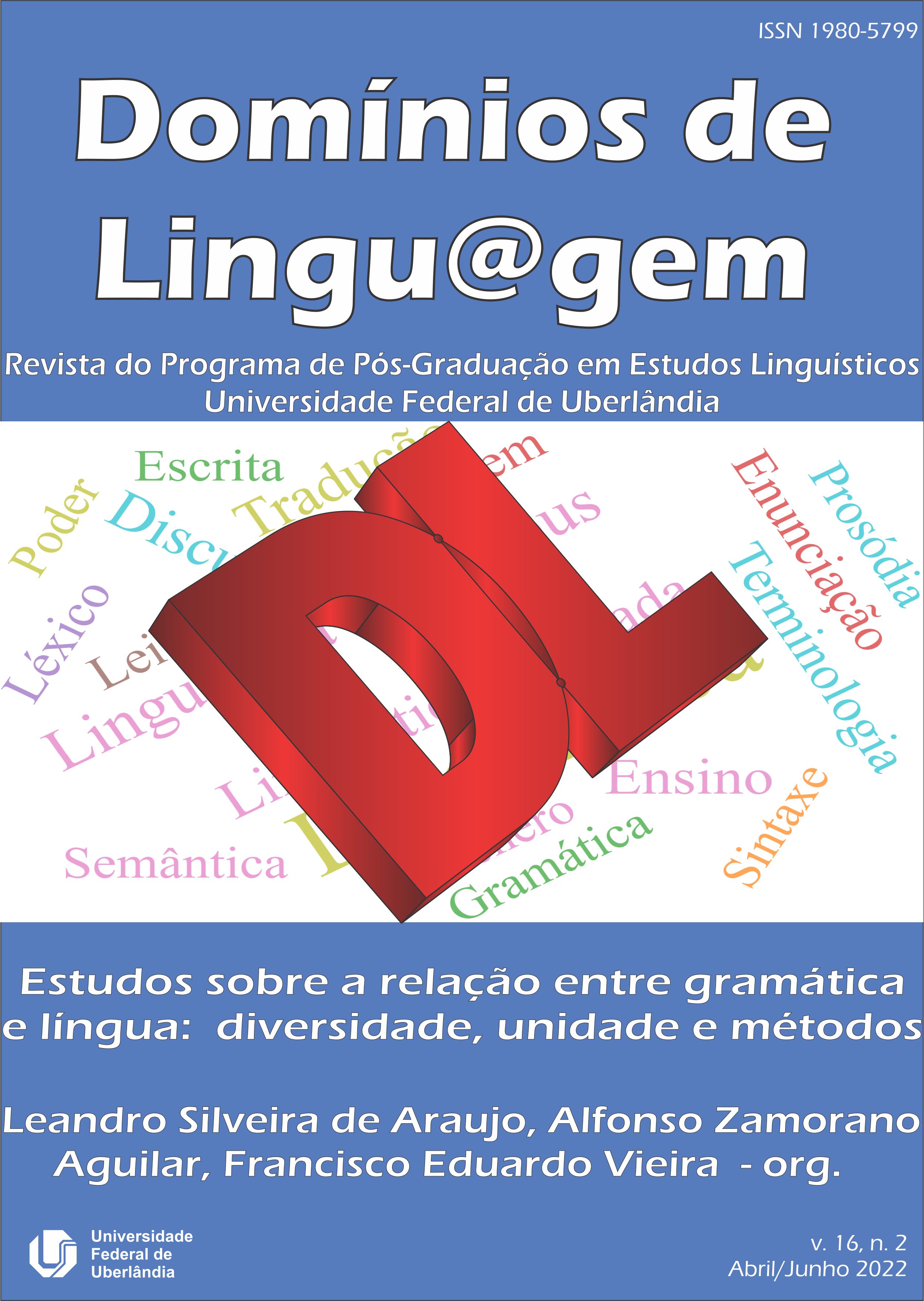Gramática da Intercompreensão
DOI:
https://doi.org/10.14393/DL50-v16n2a2022-8Palavras-chave:
Intercompreensão, Gramática, Didática, Línguas EstrangeirasResumo
O presente artigo pretende refletir sobre a relação entre língua e gramática no âmbito das abordagens plurais, e mais precisamente da didática da intercompreensão. A tese que se defende neste texto sugere que o ensino de gramática através do trabalho com diferentes línguas estrangeiras em paralelo pode proporcionar uma aprendizagem de línguas mais significativa. Ao se analisar exercícios gramaticais em materiais didáticos de intercompreensão, chega-se à conclusão que a didática da intercompreensão permite uma prática pedagógica da gramática mais consciente e contextualizada, que não só valoriza o repertório linguístico do(a) estudante, como também mobiliza seus conhecimentos prévios para apoiar a aprendizagem da(s) nova(s) línguas estrangeiras ou adicionais. Esta breve reflexão é concluída com uma discussão sobre o potencial pedagógico da adoção de uma abordagem plurilíngue para o ensino de línguas estrangeiras. São apresentadas, nesse sentido, algumas reflexões sobre os benefícios e também os desafios que a didática da intercompreensão aporta para o trabalho de professores e professoras de LE.
Downloads
Referências
BALOTIN, F. As ferramentas da intercompreensão e o ensino do passé composé em cinco materiais de FLE. 114f. Dissertação de Mestrado. Universidade Federal do Paraná, Curitiba, 2020.
BERMÚDEZ, M. A. O. Siempre me olvido de tocar la campaniña: a presença da intercompreensão entre duas línguas próximas e a negociação de significado. 136f. Dissertação de Mestrado. Faculdade de Letras, UNISINOS, São Leopoldo, 2016.
BONVINO, E. et al. EuRom5: Lire et comprendre cinq langues romanes. Milano: HOEPLI EDITORE, 2011.
BRITO, K. S. A Abordagem da Intercompreensão na aprendizagem de línguas. Ensino & Pesquisa, v. 14, 2016.
CHÁVEZ, G. T.; FARÍAS, P. M.. Manual Interlat : Comprensión escrita en portugués, español y francés. Valparaíso : Ediciones Universitarias de Valparaíso, 2007.
CYRINO, J. P. L. Tipologia Linguística: Métodos, Generalizações E Diacronia. Macabéa-Revista Eletrônica do Netlli, v. 8, n. 2, p. 306-322, 2019. DOI https://doi.org/10.47295/mren.v8i2.1908
DE OLIVEIRA, G. M.; MORELLO, R. La frontera como recurso: el bilingüismo portugués-español y el Proyecto de Escuelas Interculturales Bilingües de Frontera en el MERCOSUR (2005-2016). Revista Iberoamericana de Educación, v. 81, n. 1, p. 53-74, 2019. DOI https://doi.org/10.35362/rie8113567
DEL BARRIO, María Matesanz. Conciencia lingüística en la construcción de discursos multilingües: la intercomprensión espontánea en portuñol. Revista Iberoamericana de Educación, v. 81, n. 1, p. 75-96, 2019. DOI https://doi.org/10.35362/rie8113557
DEL OLMO, F. J. C.; MUÑOZ, A. M. E. La intercomprensión como herramienta para la integración educativa en el espacio sudamericano: posibilidades, dinámicas y límites a partir de las experiencias del programa PEIF y de la UNILA. Revista Iberoamericana de Educación, v. 81, n. 1, p. 115-134, 2019. DOI https://doi.org/10.35362/rie8113524
ERAZO MUÑOZ, A M. Mutual intelligibility in the plurilingual context of the University of Latin-American integration: experiences, contact and plurilingual interaction. 271f. Tese de Doutorado. Université Grenoble Alpes, Grenoble, 2016. Disponível em: https://tel.archives-ouvertes.fr/tel-01370807/document. Acesso em: 28 jun. 2021.
ESCUDÉ, P.; JANIN, P. L’école, la langue unique et l’intercompréhension: obstacles et enjeux de l’intégration. Synergies Europe, v. 5, p. 115-125, 2010.
ESCUDÉ, P.; JANIN, P. L’Intercompréhension, clé du plurilinguisme. Paris: CLE International, 2010.
FERREIRA, F. P. dos S. Aspectos da comunicação multilíngue: o portunhol como língua de contato na UNILA. Monografia. 50f. Universidade Federal da Integração Latino-Americana, Foz do Iguaçu, 2021.
FRANCHI, C. Mas o que é mesmo gramática? In: POSSENTI, S. (org.) Mas o que é mesmo “gramática”? São Paulo: Parábola Editorial, 2006.
FRANCHI, C. Criatividade e Gramática. São Paulo: SE/CENP, 1991. 39p.
GAJO, L. D’une société à une éducation plurilingue: constat et défi pour l’enseignement et la formation des enseignants. Synergie Monde, v. 1 , p. 62–66, 2006.
GAJO, L. L’intercompréhension entre didactique intégrée et enseignement bilingue. In: S’entendre entre langues voisines: vers l’intercompréhension. Chêne-Bourg: Georg Editeur, 2008. p. 131-150.
GAJO, L. Le plurilinguisme dans et pour la science : enjeux d’une politique linguistique à l’université. Synergies Europe, n° 8, p. 97–109, 2013.
LIMÃO, P. C. de P. O" portunhol" da América Latina no ciberespaço: De interlíngua e língua de fronteira a língua de intercompreensão e língua literária sem fronteiras. De volta ao futuro da língua portuguesa. Atas do V SIMELP-Simpósio Mundial de Estudos de Língua Portuguesa, p. 2099-2116, 2017.
PERINI, M. A. Princípios de linguística descritiva: introdução ao pensamento gramatical. São Paulo: Parábola Editorial, 2006.
PERINI, M. A. Estudos de gramática descritiva. São Paulo: Parábola Editorial, 2008.
PUREN, C. Concepts et conceptualisation en Didactique des Langues: Pour une épistémologie disciplinaire. Didáctica. Lengua y literatura, v. 10, p. 271-288, 1998.
RIBEIRO, J.; NUNES, N. Discursos sobre o bilinguismo em contexto intercultural de Ensino na unila: dois pesos e outras medidas. Cenas Educacionais, vol. 3, p. 7481-7481, 2020.
SATELES, R. do P. Intercompreensão: o tratamento lexical de línguas românicas. Monografia. Universidade de Brasília, 2014.
STURZA, E. R. Portunhol: a intercompreensão em uma língua da fronteira. Revista Iberoamericana de Educación, v. 81, n. 1, p. 97-113, 2019. DOI https://doi.org/10.35362/rie8113568
SOUZA, R. E. G. de. Didática do plurilinguismo: efeitos da intercompreensão de línguas românicas na compreensão de textos escritos em português. 180f. Tese de doutorado. Universidade Federal do Rio Grande do Norte. Centro de Ciências Humanas, Letras e Artes. 2013.
Publicado
Edição
Seção
Licença
Copyright (c) 2006 Valdilena Rammé

Este trabalho está licenciado sob uma licença Creative Commons Attribution-NonCommercial-NoDerivatives 4.0 International License.
Autores que publicam nesta revista concordam com os seguintes termos da licença Creative Commons
CC BY-NC-ND 4.0: o artigo pode ser copiado e redistribuído em qualquer suporte ou formato; os créditos devem ser dados ao autor original e mudanças no texto devem ser indicadas; o artigo não pode ser usado para fins comerciais; caso o artigo seja remixado, transformado ou algo novo for criado a partir dele, o mesmo não pode ser distribuído.
Autores têm autorização para assumir contratos adicionais separadamente, para distribuição não-exclusiva da versão do trabalho publicada nesta revista (ex.: publicar em repositório institucional ou como capítulo de livro), com reconhecimento de autoria e publicação inicial nesta revista.









